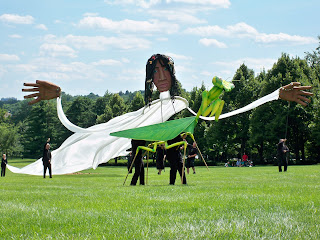

 Cindy Sherman
Cindy Sherman found a way to make herself look like many different ladies, specifically actresses, in her
Untitled Film Series. Her concept of starting with one constant and placing it in with variables such as camera angles, clothes, hair styles, expressions, etc. is simple but remarkable.
That same philosophy can be true to many art forms not just photography or acting. From one body of clay a maker could create extremely different results. Take a finished piece and place it in the gallery setting, it could have a regal and sophisticated tone. But place that same piece and put it in someone's cabinet- what atmosphere does it have? Not the same one in the gallery. A sculpture can have a completely different look or even meaning simply by placing it outside vs. inside or inside vs. outside. Presentation holds a lot of weight in the outcome.
For a brief moment in history, I wound up taking a hip-hop class. This only happened because my friend needed a ride and she convinced me to stay and dance instead of leaving and coming back to pick her up.
I CANNOT dance.
My body just won't connect dance moves quickly, especially hip hop. Maybe if there is a slow-mo hip hop I would have a chance, but even when I did get it down I looked terrible, like the moves didn't fit me. But the teacher said something every class that is true for anything, I believe.
"Mechanics is 50% of the game, the other 50% comes from presentation"


 Installing off campus for A Sense of Place was inspiring and informative. Trying to fit my studio working studio became a problem solving situation I needed to face head on; I needed to balance my allotted time with the piece's stages of drying. I worked alongside the curators of the show in the stressful finishing times before the show. Their passion for the show and the work in the show made me focus on my work, making it not so much for me but for them, for the people who would see it. Although I wish I could have had an extra day for more touch ups, I learned how to better budget my time for the next show or time limit I need to function within. The preparation for the show was filled with encouragement from my peers and the curators.
Installing off campus for A Sense of Place was inspiring and informative. Trying to fit my studio working studio became a problem solving situation I needed to face head on; I needed to balance my allotted time with the piece's stages of drying. I worked alongside the curators of the show in the stressful finishing times before the show. Their passion for the show and the work in the show made me focus on my work, making it not so much for me but for them, for the people who would see it. Although I wish I could have had an extra day for more touch ups, I learned how to better budget my time for the next show or time limit I need to function within. The preparation for the show was filled with encouragement from my peers and the curators.






































 two manned butterflies were very elegant
two manned butterflies were very elegant the preying mantis was my favorite
the preying mantis was my favorite flower petals come down the lane and formed a circle where a hula hoop girl popped out of the center
flower petals come down the lane and formed a circle where a hula hoop girl popped out of the center bugspray wears converse, thus anything/ anyone wearing converse is bad on the environment. bugs fight back on bugspray by ganging up
bugspray wears converse, thus anything/ anyone wearing converse is bad on the environment. bugs fight back on bugspray by ganging up mother earth thanks the bugs
mother earth thanks the bugs

